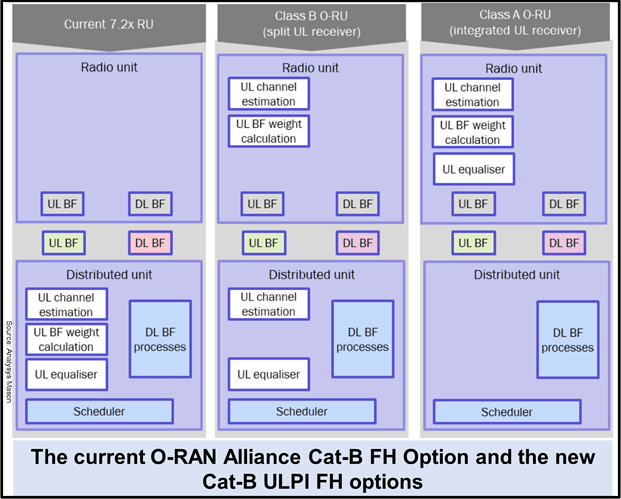-
My friend: Hi Ibrahim, I have a question for you.
- Me: Go ahead, please.
-
My friend: What is the new ULPI FH option that is adopted by the O-RAN Alliance?
- Me: To answer this question, let me go back in time to understand what are the FH options chosen originally by O-RAN Alliance and why there are new FH options suggested. So, the start was when O-RAN Alliance selected option 7.2x as the FH option that can be used for Open RAN and under this option, two types of RUs were nominated. The 1st one is Cat-A, which is low performance RU that supports up to 8T8R, it doesn’t support mMIMO and is suitable for locations with low traffic needs such as rural areas. The 2nd one is Cat-B, which is supporting mMIMO and BF up to 64T64R which is used in locations with high-capacity requirements.
-
My friend: So, why do we need a new option for FH?
- Me: The performance of Cat-A RUs was satisfactory for remote areas with the existing FH capacity where most of the L1 processing is done inside the DU. However, the UL performance of Cat-B RUs with mMIMO was disappointing, even one vendor compared the UL mMIMO performance of Cat-B RUs against its purpose-built RAN and found that there was a big difference in performance. The low performance of Cat-B RUs is due to having most of the L1 functions inside the DU such as the UL channel estimation, BF weight calculations, and the equalizer. So, there is a certain delay as the BF done in the RU is based on the previous channel information calculated in the DU which will cause performance problems specially with high interference load, and a lot of UE mobility. So, O-RAN Alliance members realized that there is a need for a new FH option.
-
My friend: Which is the ULPI FH option, right?
- Me: Yes, it is called ULPI (UL Performance Improvement) as it targets to improve the UL performance by re-organizing where the most demanding RAN functions, associated with mMIMO BF, are processed. So, two proposals were brought forward to improve the Cat-B mMIMO UL performance which are Cat-B ULPI-A and Cat-B ULPI-B. Cat-B ULPI-A places the whole UL receiver in the RU including the equalizer which solves the original problem of implementing mMIMO RUs in Open RAN with existing FH capacity, while also enabling easy multi-vendor interoperability and ensures the highest UL performance. On the other hand, Cat-B ULPI-B splits the UL receiver, carrying out channel estimation in both units, DU& RU, and keeping the equalizer in the DU, and so we need to ensure good coordination between DU and RU to get full radio performance which can be challenging specially when channel estimation algorithms in RU and DU come from two different vendors. So, as per O-RAN Alliance, RU vendors can implement either Cat-B ULPI-A or Cat-B ULPI-B but, to ensure interoperability, the DU vendors should support both version A and version B RUs.
-
My friend: Thank you so much.
- Me: You are welcome.
LinkedIn: ![]()

